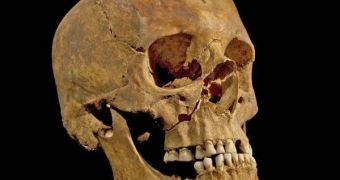Back in September 2012, a team of archaeologists succeeded in unearthing some human remains that had been buried for centuries under a car park in Leicester, in the East Midlands of England. The skull that was found amongst these remains has now been revealed, and rumor has it that it belongs to Richard III.
For those unaware, Richard III was a 15th-century monarch, whose death in 1485 brought to an end the so-called the Wars of the Roses (i.e. a series of dynastic wars fought between the houses of Lancaster and York, together with their supporters, for the throne of England).
In the aftermath of his death, the House of Tudor came to reign over the country.
Ever since the remains were first found, several archaeologists expressed their belief that they might belong to said 15th-century monarch.
Still, it is only now that the specialists in charge of figuring out the identity of the man found buried under said car park in Leicester have agreed to reveal a picture of the skull allegedly belonging to Richard III.
Information made available to the general public thus far says that the skull displays signs of having suffered a severe blow, and that the spine excavated together with it had an arrowhead embedded in it.
Apparently, all these findings are consistent with various historical records, which maintain that Richard III experienced a rather violent death.
Daily Mail quotes Dr. Jo Appleby, a lecturer in Human Bio Bioarcheology presently working with the University of Leicester's School of Archeology and Ancient History, who made a case of how, “The skull was in good condition, although fragile and was able to give us detailed information about this individual.”
Furthermore, “It has been CT scanned at high resolution in order to allow us to investigate interesting features in as much detail as possible. In order to determine whether this is Richard III we have built up a biological profile of its characteristics. We have also carefully examined the skeleton for traces of a violent death.”
It is expected that, in a matter of hours, the archaeologists will also go public with the results of their tests, and clarify once and for all whether or not these remains belong to Richard III.

 14 DAY TRIAL //
14 DAY TRIAL //